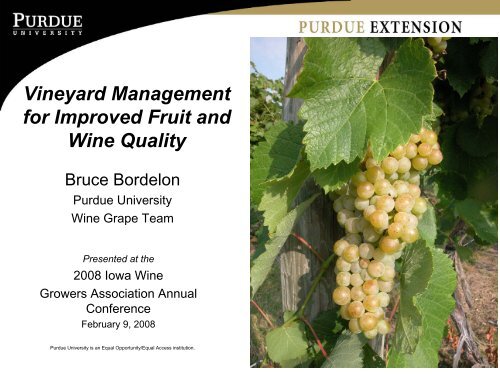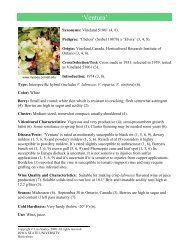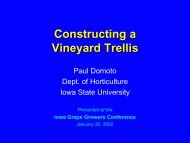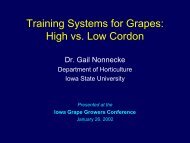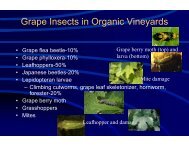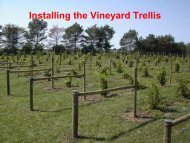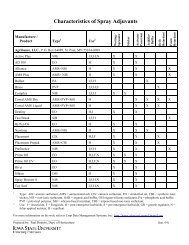Vineyard Management for Improved Fruit and Wine Quality
Vineyard Management for Improved Fruit and Wine Quality
Vineyard Management for Improved Fruit and Wine Quality
- No tags were found...
Create successful ePaper yourself
Turn your PDF publications into a flip-book with our unique Google optimized e-Paper software.
<strong>Vineyard</strong> <strong>Management</strong><strong>for</strong> <strong>Improved</strong> <strong>Fruit</strong> <strong>and</strong><strong>Wine</strong> <strong>Quality</strong>Bruce BordelonPurdue University<strong>Wine</strong> Grape TeamPresented at the2008 Iowa <strong>Wine</strong>Growers Association AnnualConferenceFebruary 9, 2008Purdue University is an Equal Opportunity/Equal Access institution.
<strong>Vineyard</strong> <strong>Management</strong> Principles• Variety/site suitability• Proper crop balance• Appropriate harvest decisions• Appropriate training systemPurdue University is an Equal Opportunity/Equal Access institution.
Matching Variety to Site• Cold hardiness-winter temperature– Zone 4b (-20 to -25F)– Zone 5a (-15 to -20F)• Date of ripening-temperature during ripeningperiod– Early (120 days from bloom to harvest)Purdue University is an Equal Opportunity/Equal Access institution.
USDA Plant Hardiness Zone Map-20 to -30˚F-10to -20˚FPurdue University is an Equal Opportunity/Equal Access institution.
Match Cold Hardiness to Climate• Very hardy (-20 to -30˚F)– Frontenac, LaCrescent, Marquette, DeChaunac, LaCrosse,Edelweiss, St. Croix, St. Pepin, Esprit• Hardy (-15 to -25˚F)– Concord, Steuben, Foch, Noiret, Corot noir, Vignoles,Chancellor, Norton, Melody• Moderately hardy (-10 to -20˚F)– Seyval, Chardonel, Cayuga white, Traminette• Slightly hardy (-5 to -15˚F)– Chambourcin, Vidal• Tender (0˚F to -10˚F)– All viniferaPurdue University is an Equal Opportunity/Equal Access institution.
Purdue University is an Equal Opportunity/Equal Access institution.Cold damage
Match Ripening Date to Climate• Heat units (growing degree days base 50˚F)– Iowa varies between 3,500 <strong>and</strong> 2,500– Cultivars vary season of ripening, need <strong>for</strong> heat• Frost Free Days– In Iowa season length varies from 140 to 170+ days– Mid to late ripening varieties need 160-180 days– Early varieties need lessPurdue University is an Equal Opportunity/Equal Access institution.
Purdue University is an Equal Opportunity/Equal Access institution.
Purdue University is an Equal Opportunity/Equal Access institution.
Theories on Heat Affects• Cali<strong>for</strong>nia Zones I-V based on GDDs base 50˚F (Amerine &Winkler, 1944)• Temps >86˚F day & >64˚F night are detrimental to fruit qualityOptimal temperature is 68-77˚F day, 59-68˚F night (Coombe,1987)• Mean temp of 64-70˚F during final month of ripening(Gladstones, 1992)• Daily heat load (>22˚C) during last 28 days (Happ, 2004)• <strong>Quality</strong> ripening days (daily heat accumulation base 50
Match Variety to Ripening SeasonTemperatures<strong>Fruit</strong> quality is best when ripened under warmdays <strong>and</strong> cool nights– Don’t grow early ripening grapes in a long season,hot area (excess heat)• Low sugars, low acid, high pH, poor color, poor flavor &aroma– Don’t grow late ripening grapes in a short season,cool area (insufficient heat)• Low sugar, high acid, low pH, unripe herbaceous flavorsPurdue University is an Equal Opportunity/Equal Access institution.
Relative Date of RipeningEarlyFoch, Marquette, St. Croix, EdelweissMidLateFrontenac, LaCrescent, Seyval, LaCrosse,Chardonel, Cayuga White, Vignoles,DeChaunac, Traminette, Noiret, Corot noir, etc.Chambourcin, Norton, VidalPurdue University is an Equal Opportunity/Equal Access institution.
Purdue University is an Equal Opportunity/Equal Access institution.
Purdue University is an Equal Opportunity/Equal Access institution.
Iowa Ripening Season TemperaturesLocationAugustMax Min MeanSeptemberMax Min MeanOctoberMax Min MeanBurlington(1st FF Nov 1)Des Moines(1st FF Oct 30)Sioux City(1st FF Oct 18)84 64 74 77 55 66 65 43 5484 64 74 76 54 65 64 43 5384 62 73 76 51 64 64 39 52Gladstones suggested 64-70˚FPurdue University is an Equal Opportunity/Equal Access institution.
Appropriate Varieties <strong>for</strong> Iowa?Varieties cold hardy enough <strong>for</strong> region• All the early to mid season varieties shouldripen well.• Late varieties might not ripen fully in someyears.Purdue University is an Equal Opportunity/Equal Access institution.
Rainfall During RipeningRainfall between veraison <strong>and</strong> harvest almostalways leads to a reduction in fruit quality– Occurrence of bunch/fruit rotsVignoles, Seyval, etc are very prone to bunch rotsLaCrescent, Frontenac, etc are more tolerant– Dilution of sugar, acid, flavorsHarvest decisions are often influenced byrainfall <strong>and</strong> resulting rotsPurdue University is an Equal Opportunity/Equal Access institution.
Iowa Ripening Season PrecipitationLocationBurlington(Total 27.6)Des Moines(Total 32.3)Sioux City(Total 25.2)AugustMean inchesSeptemberMean inchesOctoberMean inches3.16 2.70 2.094.07 3.07 2.353.10 2.65 1.75Purdue University is an Equal Opportunity/Equal Access institution.
Appropriate Harvest Decisions• Sugar, acid <strong>and</strong> pH?• Flavor, aroma?• Skin <strong>and</strong> seed maturity?• Problem with MN varieties <strong>and</strong> high acidity.– As we wait <strong>for</strong> TA to drop, flavors are lost, fruit shrivels…• Problem with NY varieties: low sugar <strong>and</strong> acid– What guidelines will be used to harvest these?• Berry Sensory Workshop July-August 2008Purdue University is an Equal Opportunity/Equal Access institution.
Achieving Balance• The ultimate goal in grape growing is finding theproper balance between vegetative vigor <strong>and</strong> fruitproduction.– Achieving proper balance leads to reduced variability <strong>and</strong>improved quality….Sustainability.– Produce maximum yields of highest quality fruit possible• Balance depends on site (climate, soils), variety &rootstock (if applicable), viticultural practices, etc.• Pruning <strong>and</strong> crop load adjustment are the basic tools<strong>for</strong> achieving balance.Purdue University is an Equal Opportunity/Equal Access institution.
Characteristics of Balanced Vines• Cane pruning weights of 0.2 to 0.4 lb per ft of trellis• Crop load ratio (yield:pruning wt) of 5-10 (vinifera)or 8-12? (American/hybrids)• 4-5 shoots per ft of trellis• Shoot length 4-6 feet (untrimmed)• Internode length 4 - 6 inches• Minimal lateral shoots• 1.5 - 2 leaf layers maxPurdue University is an Equal Opportunity/Equal Access institution.
Achieving Balance though Pruning• Pruning is the annual removal of wood fromthe previous season.• Pruning is the primary method of adjustingcrop size (yield) to balance vines.• Basics:– Each bud (node) retained produces one shoot– Each shoot produces 1-3 clusters– Each shoot produces leaves with capacity to ripenfruitPurdue University is an Equal Opportunity/Equal Access institution.
How much to prune? ~90%of 1-year-old wood (canes)pruned each yearPurdue University is an Equal Opportunity/Equal Access institution.
Balanced Pruning• Research based method developed by NelsonShaulis to quantify pruning severity.• Uses a measurement -the weight of canes (previousseason’s growth) to estimate a vine’s capacity toripen a crop.• Pruning weight (aka vine size) is applied to a <strong>for</strong>mulato determine the appropriate number of buds toretain.• Pruning <strong>for</strong>mulas are based on the growth <strong>and</strong>fruiting characteristics of a variety.Purdue University is an Equal Opportunity/Equal Access institution.
Balanced Pruning• Vine capacity often varies greatly between adjoiningvineyard blocks, <strong>and</strong> even vines within a row.• Balanced pruning should help avoid:– under pruning (over cropping) small vines.– over pruning (under cropping) large vines.– variability in fruit quality.• Balancing pruning is the first step in achieving theannual desired fruit quality, <strong>and</strong> with maintaining orimproving the vine’s capacity <strong>for</strong> the following season.– Maximum yields without sacrificing vine sizePurdue University is an Equal Opportunity/Equal Access institution.
Balanced Pruning FormulasGrape Variety Pruning Formula Cluster ThinningAmerican 30+10 NoFrench Hybrids 20+10,15+10,5+10Yes, usuallyNew Hybrids 20+20, 20+10? Yes / No?Seedless Table 30+10 YesVinifera 20+20 Yes / No?Purdue University is an Equal Opportunity/Equal Access institution.
Example of Balanced Pruning• Pruning Formula: 30 + 10– Leave 30 nodes (“count buds”) <strong>for</strong> first pound ofcanes removed plus 10 <strong>for</strong> each additional pound• Pruning wt = 1 lb – leave 30 nodes• Pruning wt = 2 lb – leave 40 nodes• Pruning wt = 2.5 lb – leave 45 nodes• Pruning wt = 3 lb – leave 50 nodesPurdue University is an Equal Opportunity/Equal Access institution.
Balanced Pruning Reality• Un<strong>for</strong>tunately, achieving balance through pruning aloneis usually not possible• Balanced pruning only works well on American-typevarieties• Hybrids tend to be more fruitful– More clusters per shoot– Very large clusters– More shoots per “count” node• Hybrids require more careful management to maintain“vine balance”Purdue University is an Equal Opportunity/Equal Access institution.
One shoot per budPurdue University is an Equal Opportunity/Equal Access institution.
Non-count shootsPurdue University is an Equal Opportunity/Equal Access institution.
Non-count shootsPurdue University is an Equal Opportunity/Equal Access institution.
Non-count shootsPurdue University is an Equal Opportunity/Equal Access institution.
Problem with balanced pruning <strong>for</strong>mulas:– On small vines they tend to suggest a very low number ofshoots, which would produce far below the optimum leafarea <strong>for</strong> the vine. (e.g. 5+10 <strong>for</strong> Seyval)Another approach to balancing vines– Instead of applying a <strong>for</strong>mula to determine number of buds,why not leave enough shoots to fill the trellis space then usea <strong>for</strong>mula to adjust the number of clusters to meet a targeted“crop load” value?– That will help maximize “vine capacity” (leaf area) withoutcausing vine imbalance.Purdue University is an Equal Opportunity/Equal Access institution.
Using Target Crop Load Approach1. Prune <strong>and</strong> thin to 40-50 shoots per vine (at 8 ft vine spacing)2. Use long-term average cluster weight data to calculate numberof clusters needed <strong>for</strong> yield that will give a desired “crop loadratio” based on “vine size” data.3. Thin clusters to appropriate numberRequired data:• Vine size (pruning weight)• Vine yield (crop weight)• Cluster weight (number of clusters per vine)Purdue University is an Equal Opportunity/Equal Access institution.
Variety Per<strong>for</strong>mance over 12 yearsSouthwest Purdue Ag CenterVarietyYield(lb)VineSize(lb)CroploadratioClusterwt (lb)Clustersper vineChambourcin 19 1.1 17 0.41 47 24Chardonel 17 1.0 17 0.39 44 26Seyval 22 1.0 22 0.45 49 22Norton 17 3.2 5 0.19 90 168Foch 24 2.2 11 0.21 115 105Frontenac 12 1.2 10 0.29 41 41Clusters <strong>for</strong>crop loadratio =10Purdue University is an Equal Opportunity/Equal Access institution.
Variety Per<strong>for</strong>mance over 12 yearsSouthwest Purdue Ag CenterVarietyYield(lb)VineSize(lb)CroploadratioClusterwt (lb)Clustersper vineChambourcin 19 1.1 17 0.41 47 24Chardonel 17 1.0 17 0.39 44 26Seyval 22 1.0 22 0.45 49 22Norton 17 3.2 5 0.19 90 168Foch 24 2.2 11 0.21 115 105Frontenac 12 1.2 10 0.29 41 41Clusters <strong>for</strong>crop loadratio =10Purdue University is an Equal Opportunity/Equal Access institution.
Variety Per<strong>for</strong>mance over 12 yearsSouthwest Purdue Ag CenterVarietyYield(lb)VineSize(lb)CroploadratioClusterwt (lb)Clustersper vineChambourcin 19 1.1 17 0.41 47 24Chardonel 17 1.0 17 0.39 44 26Seyval 22 1.0 22 0.45 49 22Norton 17 3.2 5 0.19 90 168Foch 24 2.2 11 0.21 115 105Frontenac 12 1.2 10 0.29 41 41Clusters <strong>for</strong>crop loadratio =10Purdue University is an Equal Opportunity/Equal Access institution.
Variety Per<strong>for</strong>mance over 12 yearsSouthwest Purdue Ag CenterVarietyYield(lb)VineSize(lb)CroploadratioClusterwt (lb)Clustersper vineChambourcin 19 1.1 17 0.41 47 24Chardonel 17 1.0 17 0.39 44 26Seyval 22 1.0 22 0.45 49 22Norton 17 3.2 5 0.19 90 168Foch 24 2.2 11 0.21 115 105Frontenac 12 1.2 10 0.29 41 41Clusters <strong>for</strong>crop loadratio =10Purdue University is an Equal Opportunity/Equal Access institution.
Variety per<strong>for</strong>mance over 6 yrs at LafayetteVarietyYield(lb)VineSize(lb)CroploadratioClusterwt (lb)Clustersper vineCayuga White 24 1.0 24 .32 75 31Corot Noir 18 1.2 16 .31 58 39Frontenac 12 0.9 13 .17 71 53LaCrescent 12 1.3 9 .18 67 72Noiret 15 2.5 5 .31 48 80Traminette 14 2.2 6 .22 64 100Clusters <strong>for</strong>crop loadratio =10Purdue University is an Equal Opportunity/Equal Access institution.
Asynchronous Berry Development in Concord35302520151050Balanced40 nodes/vine6 tons/acreBasal Mid Apical8 9 10 11 12 13 14 15 16 17 18Total SSPurdue University is an Equal Opportunity/Equal Access institution.302520151050Overcropped160 nodes/vine12 tons/acreBasal Mid Apical8 9 10 11 12 13 14 15 16 17 18Total SSSource: D. Miller, MSU
Vine Balance Summary• Pruning <strong>and</strong> crop load adjustment are the mostimportant management practices <strong>for</strong> achieving vinebalance <strong>and</strong> good fruit quality.• Goals– Balance fruit production with vegetative growthProduce maximum yields of highest quality fruit possiblewithout sacrificing vine capacity– Maintain consistent vine balance– Reduce fruit <strong>and</strong> vine variability• Growers need to collect data on yield, pruningweight, cluster weight, shoots per vine, etc.Purdue University is an Equal Opportunity/Equal Access institution.
Choosing an Appropriate TrainingSystem• Variety traits–Vigor– Growth habit– Cold hardiness– Disease susceptibility (esp. fruit rots)– Relative fruit quality• <strong>Management</strong> concerns– Mechanical or h<strong>and</strong> harvesting/pruningPurdue University is an Equal Opportunity/Equal Access institution.
Training System Goals• Position annual shoot growth <strong>for</strong> optimum exposureof fruit <strong>and</strong> leaves• Promote balanced fruit <strong>and</strong> vegetative growth• Position fruit <strong>for</strong> ease of pest management <strong>and</strong>harvest• Facilitate pruning <strong>and</strong> vineyard managementPurdue University is an Equal Opportunity/Equal Access institution.
Training Systems• High Cordon - st<strong>and</strong>ard <strong>for</strong> hybrids in the Midwest• Mid-Wire Cordon - with VSP facilitates leaf removal<strong>and</strong> improved cluster exposure to sunlight• Divided canopy systems (GDC, Scott Henry, SmartDyson, etc.) to manage high vigor varieties/sites(reduce shading, increase yields, etc.)Purdue University is an Equal Opportunity/Equal Access institution.
Matching the Training System to Growth HabitTypes of grapes Growth habit Training SystemAmerican procumbent High cordon or cane(downward)French hybrid mostly procumbent High cordonseveral upright or mid-wire cordonwith VSPEuropean mostly upright Mid or low wire(vinifera)cordon or canewith VSPPurdue University is an Equal Opportunity/Equal Access institution.
Upright VarietiesVignolesChardonelCayuga WhiteTraminettePurdue University is an Equal Opportunity/Equal Access institution.
High CordonTrainingPurdue University is an Equal Opportunity/Equal Access institution.
Purdue University is an Equal Opportunity/Equal Access institution.
Purdue University is an Equal Opportunity/Equal Access institution.Downward shootpositioning iscritical to reducingshading of thecordon
Concerns with High Cordon: ShadingPurdue University is an Equal Opportunity/Equal Access institution.
Purdue University is an Equal Opportunity/Equal Access institution.
Purdue University is an Equal Opportunity/Equal Access institution.
Purdue University is an Equal Opportunity/Equal Access institution.
Purdue University is an Equal Opportunity/Equal Access institution.Mid-wire Cordon with VSP
Purdue University is an Equal Opportunity/Equal Access institution.
Purdue University is an Equal Opportunity/Equal Access institution.
Concerns with Mid-Wire Cordon• Upright growing shoots tend to be very vigorous (strong sinkstrength)• Excessive vigor can result in low fruitfulness• Hedging is necessary to prevent shading, but may result inexcessive lateral growth, requiring additional trimming.• On high vigor sites, vine size may be too high to leaveappropriate shoots per foot of trellis <strong>and</strong> leaf layers.Purdue University is an Equal Opportunity/Equal Access institution.
Scott Henry Options4Purdue University is an Equal Opportunity/Equal Access institution.
Purdue University is an Equal Opportunity/Equal Access institution.Scott Henry System
Purdue University is an Equal Opportunity/Equal Access institution.
Purdue University is an Equal Opportunity/Equal Access institution.
Concerns with Scott Henry• Upper <strong>and</strong> lower canopy differences• Upright growing shoots tend to be very vigorous (strong sinkstrength)• Excessive vigor can result in low fruitfulness• Hedging is necessary to prevent shading, but may result inexcessive lateral growth, requiring additional trimming.• On high vigor sites, divided canopy helps maintain desiredshoots per foot of trellis <strong>and</strong> leaf layers.Purdue University is an Equal Opportunity/Equal Access institution.
Purdue University is an Equal Opportunity/Equal Access institution.Smart-Dyson Ballerina
Purdue University is an Equal Opportunity/Equal Access institution.
Training Summary• Choose training system based on:– Growth habit– Vine vigor– Cold hardiness– Disease pressure• Training system should provide well-spaceddistribution of fruiting wood with good exposure tosunlightPurdue University is an Equal Opportunity/Equal Access institution.
Traminette Training System StudyPurdue University is an Equal Opportunity/Equal Access institution.
Yield Components, Vine Size, Crop Load5 year meansTrainingSystemYield(kg/vine)PruningWt(kg/vine)Crop Load(yld/pw)Clusterwt(g)Berrywt(g)High cordon 6.29 ab 0.83 b 8.1 a102.4 1.77Mid-wirecordon5.82 b 1.06 a 6.0 b95.31.77Scott Henry 7.43 a 1.11 a 7.8 a** **** ****106.7ns1.72nsPurdue University is an Equal Opportunity/Equal Access institution.
Point Quadrat Analysis4 year meansTrainingSystemShoots/vineGaps(%)Leaf layersInteriorleaves(%)Exteriorclusters(%)High cordon54.6 b2.0 c 4.2 a 54.4 a17.8 bMid-wirecordon51.5 b7.0 b 1.9 b 32.2 b40.5 bScott Henry 79.8 a 11.0 a 1.7 b 28.8 b38.4 a******** **** *******Purdue University is an Equal Opportunity/Equal Access institution.
<strong>Fruit</strong> Composition5 year meansTrainingSystemSolubleSolids(%)TitratableAcidity(g/L)pH FVT PVTHigh cordon 22.2 7.2 a 3.140.85 5.29Mid-wirecordon22.5 6.8 b 3.160.735.71Scott Henry 22.4 7.1 a 3.14ns *** ns0.73ns5.73nsPurdue University is an Equal Opportunity/Equal Access institution.
Sensory Analysis• Can panelists detect adifference between winesfrom the training systems?• 12 trained panelists• 2002 <strong>and</strong> 2003 wines• Triangle tests– Compusense softwarePurdue University is an Equal Opportunity/Equal Access institution.
Sensory ResultsPanelists correctly detected a differencebetween HC <strong>and</strong> MWC.100 % 2003; 87.5% 2002Less likely <strong>for</strong> panelists to detect adifference between SH <strong>and</strong> MWC, or SH<strong>and</strong> HC <strong>for</strong> both years (50-60%accuracy).Purdue University is an Equal Opportunity/Equal Access institution.
Scott Henry Canopy ComparisonsTrainingSystemShoots/cordonGaps(%)LeaflayersInteriorleaves(%)Exteriorclusters(%)High cordon 54.62.0 4.2 54.417.8Mid-wirecordonScott HenryUpperScott HenryLower51.539.57.013.3 a1.91.6 b32.225.640.540.839.0 6.2 b 2.2 a 36.3 31.5ns *** **** ns nsPurdue University is an Equal Opportunity/Equal Access institution.
Scott Henry Canopy ComparisonsTrainingSystemYield(kg/vine)PruningWt(kg/vine)CaneWt(g)CropLoad(yld/pw)ClusterWt (g)BerryWt (g)High cordon 6.29 0.83 15.2 8.1 102.4 1.77Mid-wirecordonScott HenryUpperScott HenryLower5.824.31 a3.12 b1.060.75 a0.37 b20.619.09.56.05.7 b8.4 a95.3115.0 a94.9 b1.771.76 a1.34 b** **** *** *** **Purdue University is an Equal Opportunity/Equal Access institution.
Summary• Proper selection of variety to match site– Cold hardiness– Date of ripening• Proper balance between yield <strong>and</strong> vegetative vigor– Crop load adjustment through pruning <strong>and</strong> thinning– Record keeping (data collection)• Selecting an appropriate training system– Match growth habit of variety– Improve fruit/wine qualityPurdue University is an Equal Opportunity/Equal Access institution.
Acknowledgements• Patty Skinkis - Former graduate student, now AssistantProfessor of Viticulture, Oregon State University• Paul Howard - Research technician• Christian Butzke, Jill Blume, Ellie Butz - enology <strong>and</strong>sensory assistanceFunding support:• Viticulture Consortium - East• Indiana <strong>Wine</strong> Grape Council• Purdue Agriculture Research CentersPurdue University is an Equal Opportunity/Equal Access institution.


